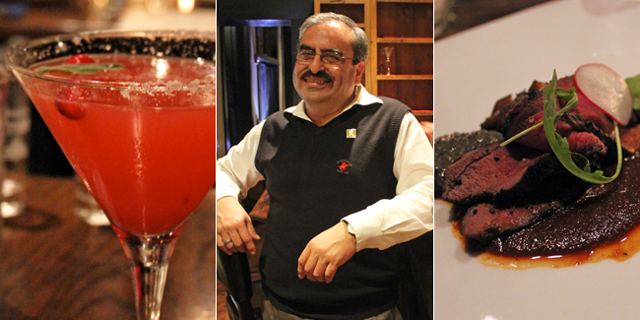“First you will taste Sopa de Calabaza Oaxaqueňa,” said the waiter as he placed a large-rimmed bowl in front of me.
Almost immediately, the orange-spiced aroma grabbed me as I gazed into the steaming squash soup. It was topped by a slowly melting square of chocolate brittle that was filled with pumpkin pepitas. I put my spoon in, careful to fill it with both equal parts soup and chocolate. The taste: sublime, both with earthy squash and rich cacao flavors, and savory, with crunchy and smooth textures.
I choked on my words, turned to my friend and said, “Have you ever tasted anything like this? It’s insanely wonderful.”
Here, in the center of chowder and lobster country, I was transported to the culinary heart of Mexico.
At Portland, Maine’s Zapoteca Restaurante y Tequileria, dishes like the pumpkin Sopa de Calabaza, Mole Poblano (chile-and-chocolate sauced meat), and Cochinitas Pibil (slow roasted pig) are making their way on to the plates and into the hearts of residents in the northeast. Maine has been ripe for a flavor revolution: its lauded restaurants and creative chef culture have been keen to embrace Latin flavors and techniques.
At the helm of this movement is a group of restaurant veterans. Zapoteca’s executive chef Shannon Bard, a self-proclaimed “farm girl, raised in Oklahoma and transplanted to Maine,” along her husband Tom Bard (a food industry maven) partnered with their long-time friend and colleague, Sergio Ramos to open the restaurant in 2011.
Their mission: provide New England diners with well-executed food that highlights the traditional flavors of southern Mexico. Ramos, a native of Guadalajara, Jalisco, Mexico, worked with the Bards to create a menu that would both showcase Shannon’s training in traditional Mexican cuisine, and his childhood and family food favorites.
In their two years of business, Bard has become a darling of the seacoast food scene. Shannon’s fiery, energetic personality couples well with her passion for food. She is a fixture at regional food shows and has been invited to cook at the James Beard House in New York in January 2014.
Bard readily states however, “I could never do this without Tom and Sergio. They are the business backbone of the operation.” The trio work non-stop; as chef, hosts, and educators, and are found on the floor every night of operation.
Shannon, Tom, and Sergio serve as managers of an ever-increasing restaurant portfolio. Their interests include the Portland homebase at Zapoteca and the newly-opened Mixteca Taqueria y Cantina in the college haven of Durham, New Hampshire.
Next, a look at what’s happening behind the bar…
[pagebreak]Devoted foodies flock to Zapoteca for the flavors, as well as its beloved bar and tequileria. Ramos is certified by the Tequila Regulatory Council of Mexico and is one of four “tequila sommeliers” in the U.S. He has made it his “mission to educate customers about good tequila and how to drink it.”
“When we opened, we started with close to fifty tequilas,” states Ramos. “For me, this was nothing. For Maine, it was a big deal. I knew that we could have so much more.” Now the bar boasts more than 100 varieties, hosting monthly tequila tasting dinners.
“I want people to see it as much more that something that is a ‘shot’ to drink. We teach our customers about the different flavors and depths of the product, “says Ramos. He laughs and says, “We don’t serve up limes with our tequilas.”
This level of education spreads to the kitchen.
“I like to be as traditional as possible with our recipes,” says Shannon Bard. Bard puts her expertise to work on ceviche, loading up the dish with cold-water lobster, sweet onion, mango, grapefruit and guava. The appetizer is one of her signature dishes.
Bard eschews the word ‘authentic’ stating, “Unfortunately, I can’t always be ‘authentic’ mainly because of geography and availability of ingredients. When we first opened, we could not always get things like good masa (corn flour) or even some chiles and raw chocolate. We have such an insane bounty of seafood and fresh produce. So I’ve learned to put my spin on it.”
A good example is the way she uses Maine venison in her Chile Frotada el Venado, accompanying the dish with local mushrooms and a flan made from huiltlacoche, Mexico’s corn fungus delicacy.
“In a way, we have to use what we have here. It’s what they would do in Mexico,” says Shannon. She states that “the ‘how’ is as important as the ‘what’ in good Mexican cooking.”
Next, get a taste of what the chefs are dishing up…
[pagebreak]Zapoteca Cranberry Sage Margarita
- 1 1/2 ounces of Patron Silver Tequila
- 1/2 ounce of Patron Citronage Orange Liqueur
- 1/2 ounce of agave Nectar
- 1 1/2 ounces fresh squeezed lime juice
- 7 fresh sage leaves
- 1 ounce cranberry puree
- 3 cranberries



![Making Mealtime Matter with La Familia: Easy Sofrito [Video]](https://thelatinkitchen.com/wp-content/uploads/2015/10/sofrito-shutterstock__0-500x383.jpg)
![Easy Latin Smoothies: Goji Berry Smoothie [Video]](https://thelatinkitchen.com/wp-content/uploads/2015/12/goji_berry-shutterstock_-500x383.jpg)
















![Fun and Fast Recipes: Fiesta Cabbage Salad [Video]](https://thelatinkitchen.com/wp-content/uploads/2015/11/fiesta_cabbage_slaw-shutterstock_-500x383.jpg)









